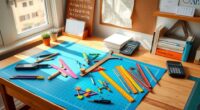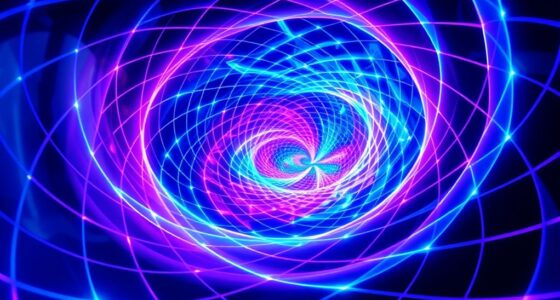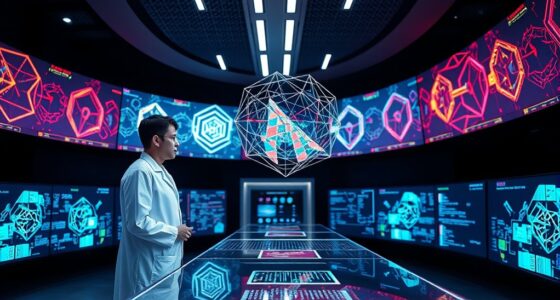Exciting innovations in 3D printing for mathematical art include high-resolution printers that transform abstract equations into detailed sculptures using advanced materials like fiber optics and resins. Parametric design and algorithms enable the creation of intricate, dynamic geometries, while virtual and augmented reality help you explore these structures interactively. Cutting-edge AI and automation further enhance design precision and efficiency. Stay with us to discover how these innovations are pushing creative boundaries and reshaping artistic expression.
Key Takeaways
- High-resolution 3D printers enable detailed geometric abstractions and manipulation of parameters for complex, customizable mathematical sculptures.
- Advanced materials like fiber optics and chemical resins allow illuminated, durable, and translucent mathematical art pieces.
- Parametric design and generative algorithms create dynamic, intricate shapes inspired by natural, fractal, and cultural patterns.
- Integration of VR and AR enhances immersive visualization and interaction with mathematical models, bridging digital and physical experiences.
- AI and automation optimize design, improve accuracy, and streamline production, expanding creative possibilities in mathematical art.
Revolutionary Techniques in 3D Printing for Mathematical Sculptures
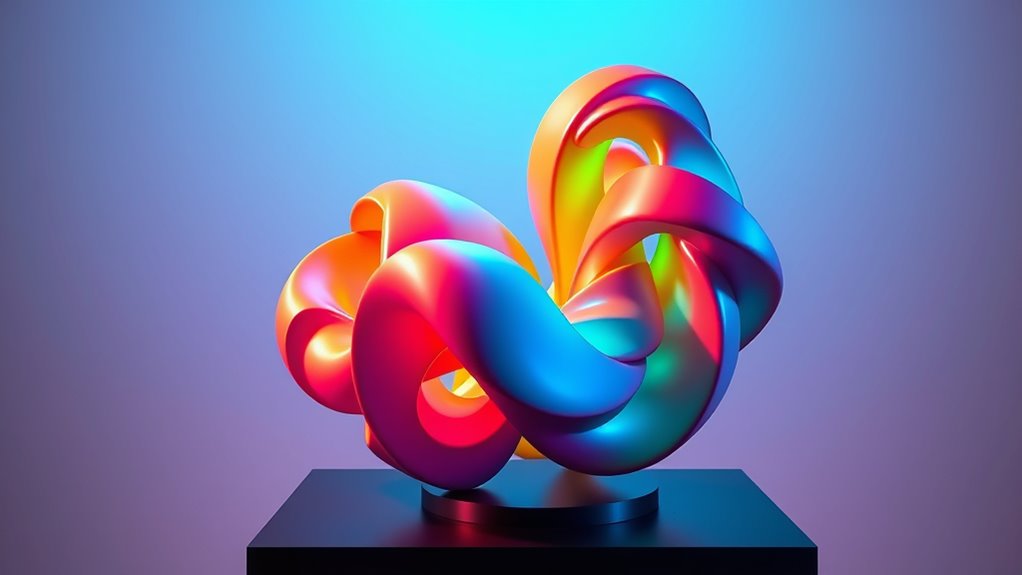
Recent advancements in 3D printing have *revealed* innovative methods for creating intricate mathematical sculptures. These techniques bring mathematical visualization to life, allowing you to craft complex forms that embody abstract concepts. By leveraging high-resolution printers, you can produce detailed geometric abstractions that highlight symmetry, fractals, and other mathematical patterns with remarkable precision. This process enables you to translate abstract equations into tangible art, offering a new dimension of exploration. You can experiment with various materials and textures to emphasize different features of the design. Additionally, understanding cultural and historical symbols can inspire the thematic elements of your sculptures, adding layers of meaning and cultural significance. These revolutionary techniques open doors for artists and mathematicians alike, bridging the gap between theoretical ideas and physical form. As a result, you can push the boundaries of creativity and mathematical expression through sophisticated 3D printing methods.
Exploring Parametric Design and Its Artistic Applications
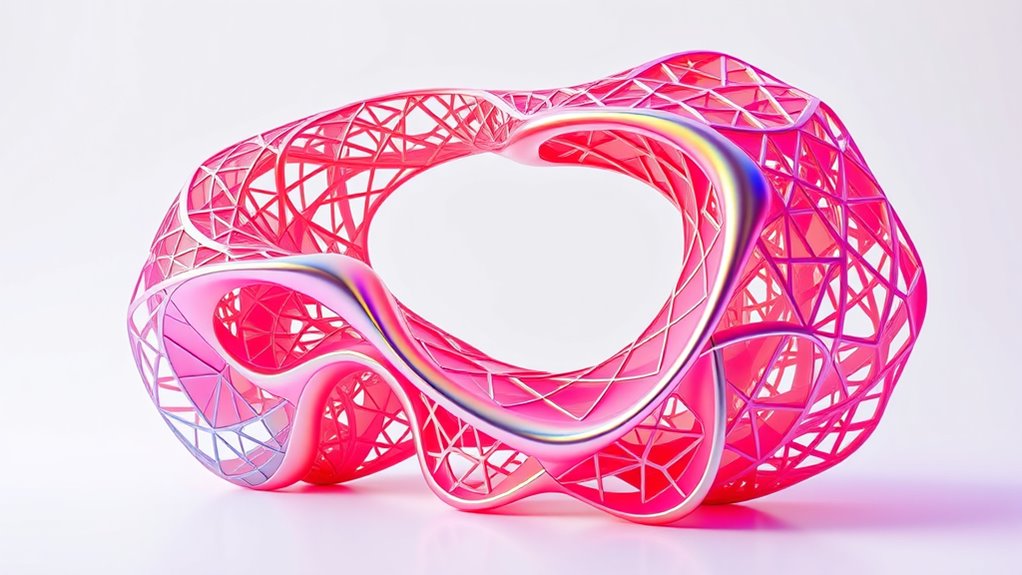
With parametric design, you can create dynamic shapes that change seamlessly based on input variables. You also have the ability to incorporate complex mathematical patterns into your artwork, making each piece unique. Plus, this approach allows you to customize artistic forms easily, pushing creative boundaries in mathematical art. Engaging in diverse experiences can further enhance your creative skills and inspire innovative designs.
Dynamic Shape Generation
Dynamic shape generation harnesses the power of parametric design to create intricate and adaptable forms in mathematical art. By adjusting parameters, you can produce complex fractal structures that evolve with each change, revealing mesmerizing patterns. Symmetry analysis plays a key role, allowing you to optimize these forms for balance and harmony. As you tweak variables, you witness real-time transformations, making your designs both visually stunning and scientifically meaningful. This approach enables you to explore endless variations, pushing the boundaries of traditional sculpture. With 3D printing, you can bring these dynamic, mathematically-inspired shapes to life, capturing their complexity and fluidity. Whether you’re designing organic or geometric forms, parametric methods empower you to craft art that’s both precise and expressive. Incorporating design principles from architecture and art can further enhance the aesthetic appeal of your creations.
Mathematical Pattern Integration
Mathematical pattern integration in parametric design opens new horizons for artistic expression by allowing you to embed complex, repeating structures directly into your creations. You can use this approach to craft intricate patterns inspired by historical motifs, blending tradition with innovation. By applying color theory, you enhance these patterns’ visual impact, creating vibrant, harmonious compositions that draw viewers in. Parametric design enables precise control over repeating elements, making it easier to experiment with symmetry and variation. As a result, your 3D printed art can evoke cultural references or abstract concepts through carefully crafted mathematical patterns. Incorporating home improvement principles like organization and decluttering can also streamline your creative workspace, fostering a more productive environment. This integration allows you to push creative boundaries, combining mathematical rigor with artistic intuition, and producing pieces that are both technically sophisticated and visually compelling.
Customizable Artistic Forms
Parametric design opens a world of customizable artistic forms by allowing you to manipulate parameters that define shape, size, and structure with precision. This approach lets you create unique, intricate designs tailored to your vision. You can experiment with:
- Dynamic color blending for vibrant, seamless shifts
- Tactile textures that enhance physical interaction
- Adjustable parameters for personalized symmetry and asymmetry
- Complex geometries that are otherwise difficult to craft manually
- Responsive designs that adapt to user input or environmental factors
- Understanding electric bike specifications can inspire innovative features in your designs, such as integrated lighting or power sources.
The Role of Computational Algorithms in Creating Complex Geometries

Computational algorithms are essential tools for designing intricate geometries in mathematical art. They enable you to implement algorithmic design techniques and generate complex forms that would be difficult to create manually. By understanding these methods, you can push the boundaries of what’s possible in 3D printed artistic structures. Additionally, high-precision rendering ensures that digital models accurately translate into physical artworks with detailed fidelity.
Algorithmic Design Techniques
By harnessing advanced algorithms, designers can generate intricate and highly detailed geometries that would be difficult or impossible to create manually. Algorithmic design techniques enable you to explore complex forms rooted in computational aesthetics, pushing the boundaries of mathematical art. You can optimize algorithms for efficiency, ensuring smooth, precise models suitable for 3D printing. These techniques allow for dynamic adjustments and real-time feedback, fostering innovation. Key applications include:
- Creating organic, flowing structures that mimic natural patterns
- Exploring parametric variations for unique, personalized designs
- Integrating symmetry and fractals for visually mesmerizing geometries
- Utilizing iterative processes to refine complex surfaces
- Enhancing design flexibility through algorithm optimization
This approach empowers you to craft compelling, mathematically inspired artworks with precision and artistic flair.
Generative Geometry Methods
Generative geometry methods harness algorithms to create complex, intricate forms that push the limits of traditional design. By leveraging computational algorithms, you can generate structures exhibiting fractal complexity and dynamic topological transformations. These methods enable the design of patterns that evolve through iterative processes, producing infinitely detailed and self-similar shapes. Topological transformations allow you to deform and connect forms in innovative ways, resulting in mesmerizing geometries. Here’s a visual overview:
| Technique | Key Feature | Application |
|---|---|---|
| Fractal Generation | Self-similar, recursive patterns | Artistic sculptures, jewelry |
| Topological Transformations | Deformation without tearing | Complex lattice structures |
| Algorithmic Iteration | Repetition for detail | Intricate surface designs |
| Geometric Morphing | Shape transformation | Dynamic installations |
| Parametric Modeling | Adjustable parameters | Customized mathematical art |
These methods access new creative avenues, blending math with art through computational power.
Material Innovations Enhancing Mathematical Artworks
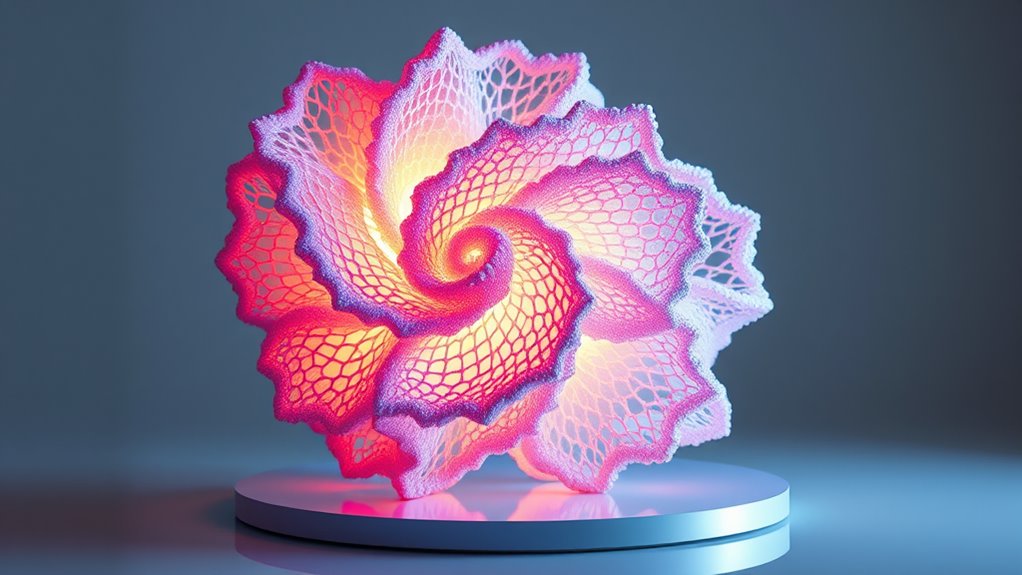
Advancements in 3D printing materials have considerably expanded the creative possibilities for mathematical artworks. You can now incorporate innovative substances like fiber optics to add dynamic lighting effects, creating mesmerizing visual displays. Chemical resins enable artists to produce highly detailed and durable structures, perfect for intricate mathematical models. These materials also allow for a variety of textures and finishes, enhancing aesthetic appeal. The integration of fiber optics makes it possible to visualize complex equations with illuminated paths, while chemical resins provide stability and clarity for transparent or translucent pieces. Additionally, new composite materials blend flexibility with strength, opening up more complex geometries. The use of hybrid/combination units that combine multiple materials and technologies further empowers you to push the boundaries of mathematical art, merging beauty with advanced functionality.
The Intersection of Virtual Reality and 3D Printing in Art Visualization
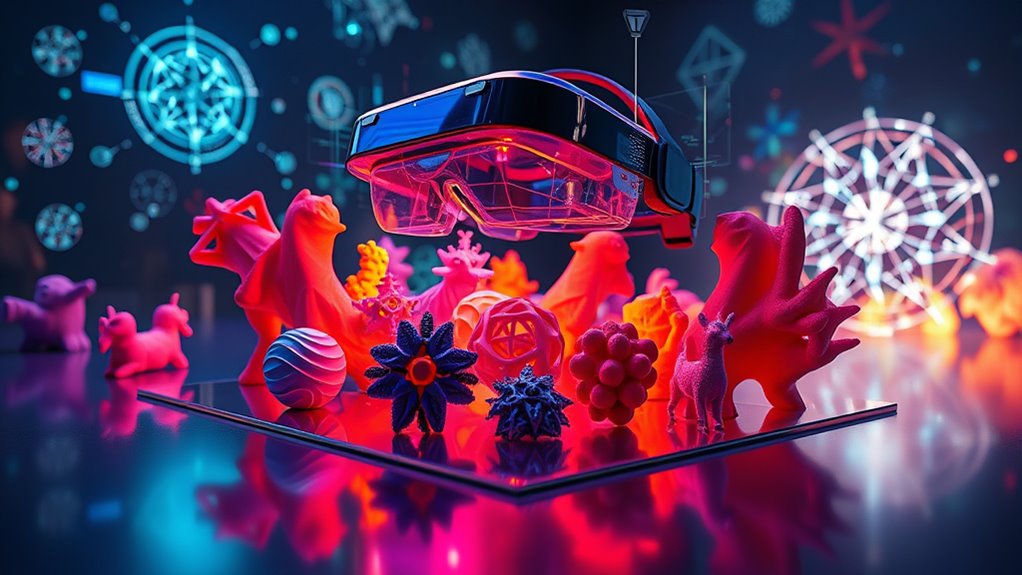
The convergence of virtual reality (VR) and 3D printing is transforming how you visualize and experience mathematical art. By combining VR with augmented reality, you can step inside intricate geometric structures, exploring their complexity from every angle. Immersive visualization allows you to interact with 3D printed models in real-time, deepening your understanding of mathematical concepts. This integration enables artists to create virtual environments where physical 3D prints serve as tangible anchors within digital spaces. You can manipulate models seamlessly, gaining new perspectives that static displays can’t offer. As VR technology advances, the boundary between digital and physical blurs, opening exciting avenues for artistic expression. This synergy enhances both appreciation and comprehension of mathematical art, making the exploration more engaging and accessible.
Case Studies: Notable Artists Pushing Boundaries With 3D Printing
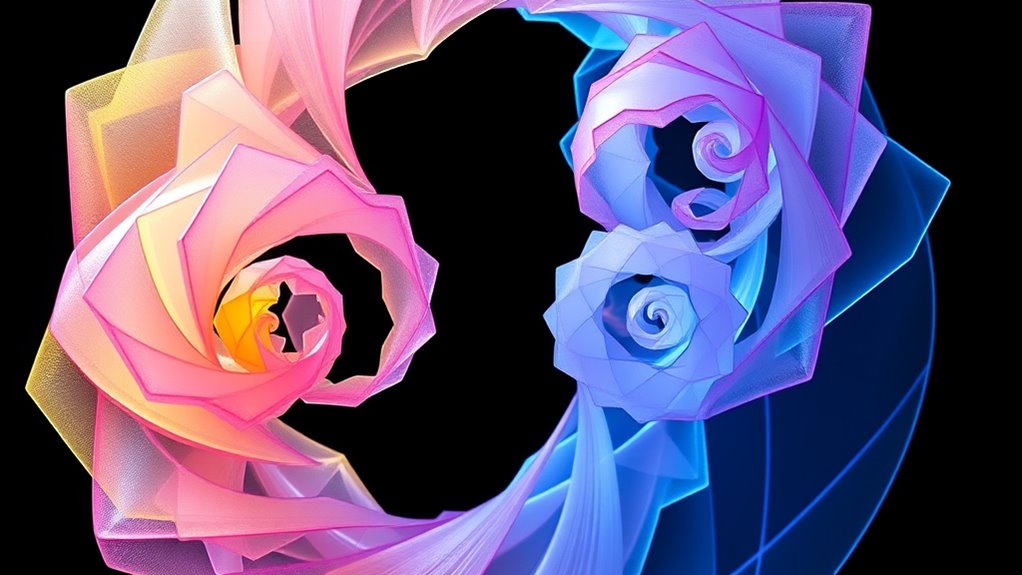
Many innovative artists are harnessing 3D printing to push the boundaries of mathematical art, transforming abstract concepts into tangible masterpieces. These artists draw on rich historical contexts and cultural influences to shape their work, blending tradition with cutting-edge technology. For example, some incorporate ancient geometric patterns, while others reflect modern societal themes. These case studies highlight how:
Innovative artists use 3D printing to transform abstract mathematical ideas into culturally inspired, tangible masterpieces blending tradition and technology.
- Artists reinterpret mathematical forms through diverse cultural lenses
- Historical mathematical concepts inspire intricate, layered sculptures
- Cultural influences shape the choice of materials and design motifs
- Cross-disciplinary collaborations extend the boundaries of mathematical art
- Personal stories and cultural identities add depth to their creations
- The integration of Honda Tuning techniques demonstrates how customization and technical innovation can influence artistic expression through technology.
Educational Uses of Mathematical 3D Prints in STEM Outreach
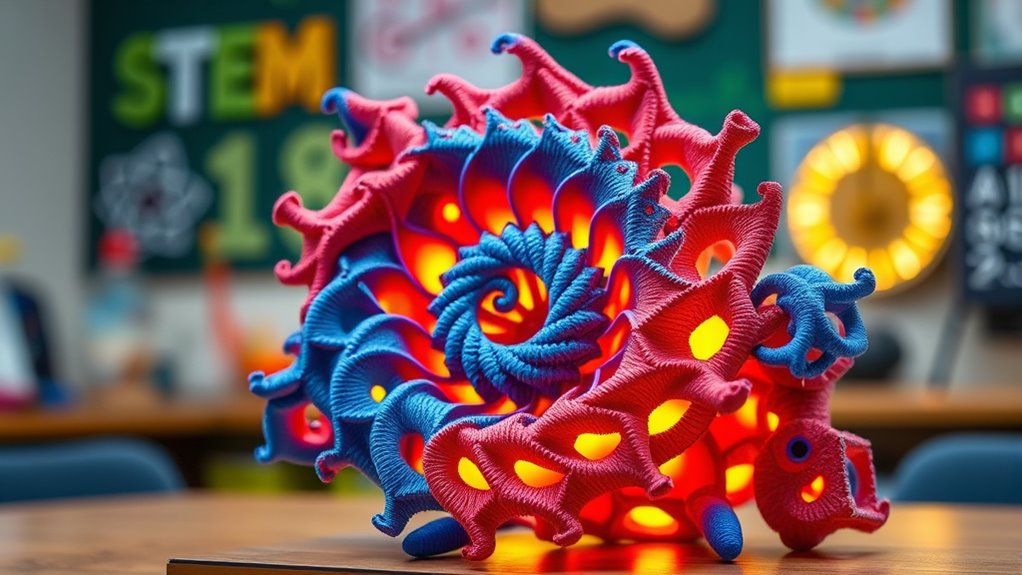
3D printed mathematical models have become powerful tools in STEM outreach, making abstract concepts accessible and engaging for learners. When you introduce mathematical models through 3D printing, you provide hands-on experiences that deepen understanding and spark curiosity. These models help students visualize complex ideas like topology, fractals, or geometric surfaces, which are difficult to grasp through textbooks alone. Incorporating 3D printed mathematical models into educational outreach programs captures students’ interest and encourages active participation. As you showcase these tangible representations, you foster a more inclusive learning environment, helping diverse audiences appreciate the beauty of mathematics. Utilizing self watering plant pots as an analogy, educators can demonstrate sustainable practices and growth concepts in a practical context. Ultimately, using mathematical models in STEM outreach enhances comprehension, inspires future innovators, and demonstrates the practical, artistic potential of mathematical 3D printing.
Future Trends: AI-Driven Design and Automated Fabrication

Advancements in artificial intelligence are revolutionizing how mathematical models are designed and fabricated through 3D printing. With AI driven design, you can generate complex, precise structures that were previously impossible to create manually. Automated fabrication streamlines the entire process, reducing time and human error. You might notice:
- AI algorithms optimizing geometric patterns for strength and aesthetics
- Rapid prototyping with minimal manual intervention
- Customized designs tailored to specific mathematical properties
- Enhanced accuracy in translating digital models into physical objects
- Integration of machine learning to improve future designs
These trends enable you to explore new artistic possibilities, pushing the boundaries of mathematical art and fostering innovative collaborations between humans and machines. The future of 3D printing lies in smart, automated systems that make complex mathematical art more accessible and dynamic. Additionally, as AI systems become more sophisticated, ongoing trustworthiness and safety measures will be crucial to ensure the reliable and ethical use of these emerging technologies.
Collaborations Between Mathematicians and Artists Shaping New Aesthetics
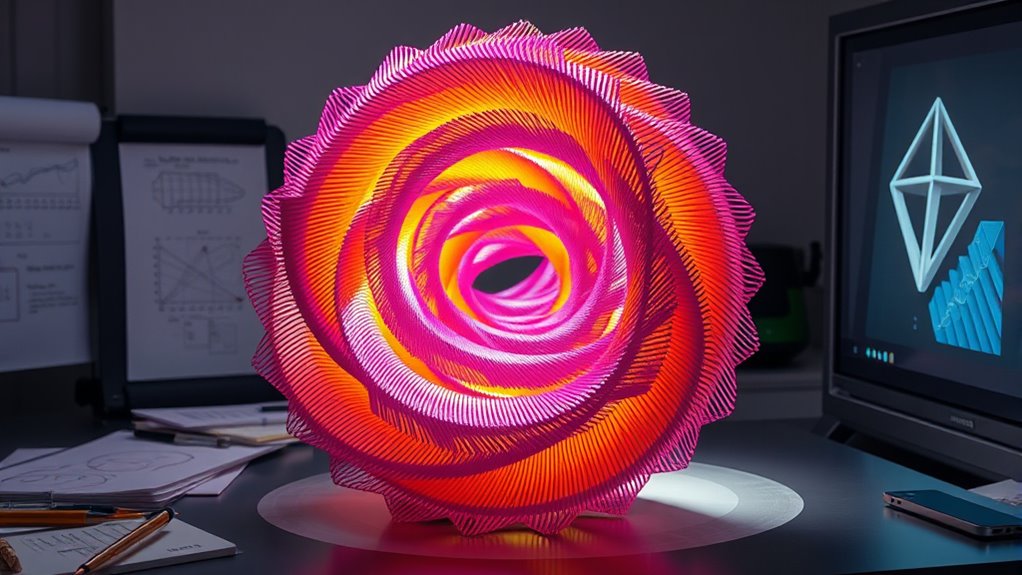
When mathematicians and artists collaborate, they create a dynamic fusion that pushes the boundaries of visual and conceptual aesthetics. This partnership enhances mathematical visualization, transforming complex concepts into compelling, tangible sculptures. Artists bring their creative expression to interpret intricate mathematical structures, making abstract ideas more accessible and engaging. These collaborations often result in innovative 3D printed artworks that blend precision with beauty, inspiring new aesthetic standards. By working together, mathematicians provide the technical insights needed for accurate visualization, while artists infuse their work with emotional impact. This synergy fosters a fresh approach to mathematical art, where beauty and complexity coexist. As a result, these collaborations open up exciting avenues for exploring mathematical concepts through artistic expression and 3D printing technology.
Frequently Asked Questions
How Do 3D Printed Mathematical Sculptures Influence Public Understanding of Complex Concepts?
You might find that 3D printed mathematical sculptures greatly enhance your understanding of complex concepts by boosting your visual literacy and cognitive engagement. These tangible models make abstract ideas more accessible, allowing you to explore intricate structures firsthand. By interacting with these sculptures, you deepen your comprehension and retain information better, fostering a more intuitive grasp of challenging mathematical principles. This hands-on approach transforms learning into an engaging, memorable experience.
What Are the Environmental Impacts of Materials Used in Advanced 3D Printing for Art?
Think of 3D printing materials as the seeds of a lush garden—they can either grow sustainably or choke the environment. When you choose sustainable materials, you reduce waste and energy use, making your art eco-friendly. Recyclability concerns highlight the importance of selecting options that can be reused or broken down easily. By being mindful, you help protect our planet while creating stunning, innovative artworks.
How Accessible Are These Cutting-Edge 3D Printing Technologies to Independent Artists?
You might find these cutting-edge 3D printing technologies somewhat accessible, but cost barriers and technical knowledge can limit independent artists. While prices are decreasing, high-end printers and materials still pose challenges. Gaining the necessary skills requires time and practice, making it harder for some to fully leverage these innovations. However, online tutorials and community workshops can help bridge these gaps, gradually opening doors for more artists to explore advanced 3D printing.
Can 3D Printed Mathematical Art Be Integrated Into Architectural or Urban Design Projects?
You can definitely integrate 3D printed mathematical art into architectural or urban design projects. It offers unique opportunities for structural integration, blending complex geometric forms seamlessly into buildings and public spaces. This approach also drives aesthetic innovation, creating visually stunning environments that challenge traditional design. By harnessing 3D printing technology, you can bring intricate mathematical patterns to life, enhancing both functionality and artistic expression in urban landscapes.
What Ethical Considerations Arise From Creating Highly Realistic or Potentially Deceptive Mathematical Models?
When creating highly realistic or potentially deceptive mathematical models, you should consider ethical issues like authenticity concerns, ensuring your models accurately represent data without misleading viewers. You also need to respect intellectual property rights, avoiding unauthorized use of proprietary formulas or designs. By maintaining transparency about your modeling processes and sources, you protect both your work’s integrity and the trust of your audience, fostering responsible innovation in mathematical art.
Conclusion
As you explore these innovations, envision vibrant sculptures unfolding from your ideas, their intricate curves and patterns brought to life through cutting-edge 3D printing. With each layer, you craft worlds where mathematics and art collide—colors, textures, and forms melding into mesmerizing displays. You become part of a future where imagination shapes reality, transforming abstract formulas into tangible masterpieces that inspire curiosity and wonder in every viewer.

